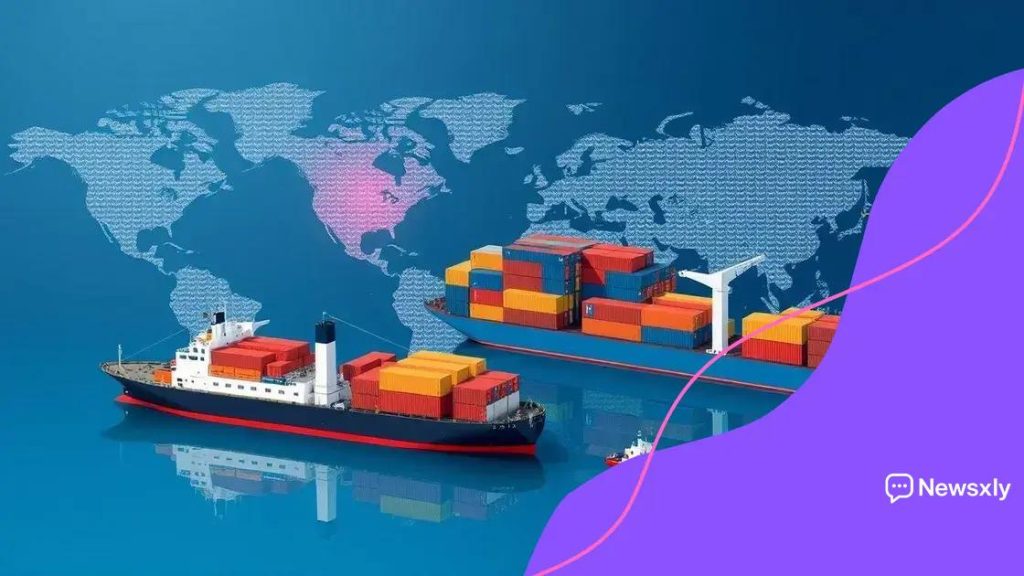Developments in global trade relationships that shape economies

Future trends in global trade dynamics include increased digitalization, a focus on sustainability, and adaptation to geopolitical shifts, all of which significantly impact how businesses engage and compete in international markets.
Developments in global trade relationships are transforming economies and influencing lives across the globe. Have you ever wondered how these shifts affect your daily purchases or job market? Let’s dive in and explore.
Emerging markets and their impact on global trade
Emerging markets are crucial players in today’s global trade landscape. These countries are rapidly growing and changing, which influences not just their economies but also the global economy as a whole.
Understanding their impact can help us navigate the ever-evolving world of commerce.
The Rise of Emerging Markets
Over the past few decades, several countries have transitioned from low-income to middle-income status. This shift has opened up new avenues for trade and investment. For example, nations like Brazil, India, and China have become major exporters of goods and services.
- Increased consumer markets
- Diverse product offerings
- Competitive pricing
- Growing technological innovations
This rise in emerging markets contributes to a more integrated global economy, creating both opportunities and challenges for established markets.
Trade Agreements and Partnerships
One significant aspect of emerging markets is their engagement in trade agreements. Many of these countries are forming partnerships that facilitate trade, reduce tariffs, and promote economic collaboration.
These agreements can lead to:
- Enhanced market access
- Stronger economic ties
- Increased foreign investments
As these markets grow, their bargaining power in negotiations also strengthens. This shift can reshape global trade dynamics.
Sustained growth in emerging markets fosters innovation. As these countries invest in technology and infrastructure, they attract international businesses looking to expand. This creates a more competitive landscape where traditional markets must adapt to stay relevant.
Overall, the emergence of these markets presents both risks and opportunities. Understanding these dynamics equips businesses and policymakers with the insights needed to thrive. As emerging markets continue to grow, their influence on global trade will undoubtedly increase.
Trade agreements: benefits and challenges
Trade agreements play a significant role in shaping the landscape of global trade. These agreements can help countries collaborate economically while also presenting challenges that must be addressed.
Let’s explore the benefits and challenges of trade agreements.
Benefits of Trade Agreements
Trade agreements lead to numerous advantages for participating countries. They can enhance economic growth and facilitate better trade relations. Here are a few key benefits:
- Increased market access for exporters
- Reduction of tariffs and trade barriers
- Encouragement of foreign investments
- Sharing of resources and technologies
Businesses can expand their reach, which ultimately promotes competition and innovation in the market.
Challenges Faced by Trade Agreements
While the benefits are significant, trade agreements also pose certain challenges. Understanding these challenges is essential for countries to craft effective policies. Some notable challenges include:
- Potential job losses in affected industries
- Disparities in power among negotiating parties
- Environmental concerns due to increased production
These factors can complicate the formation and implementation of trade agreements. It is vital for policymakers to balance the benefits while addressing the adverse effects.
In summary, trade agreements are essential for fostering international trade. They create opportunities for growth and development, but also require careful consideration of the challenges involved. As nations continue to engage in these agreements, the dynamics of global trade will evolve, demanding adaptability and foresight from all parties.
The role of technology in trade relationships

Technology plays a vital role in shaping modern trade relationships. The impact of technological advancements can be seen across various aspects of global commerce, making trade more efficient and accessible.
From communication to logistics, technology enhances the capabilities of businesses in the global market.
Advancements in Communication
Effective communication is essential for successful trade. With tools like email, video conferencing, and instant messaging, businesses can connect with partners worldwide. This connectivity streamlines negotiations and builds stronger collaborations.
- Faster decision-making
- Improved relationships with suppliers
- Increased transparency in transactions
Such advancements help businesses respond quickly to market changes and consumer demands.
Logistics and Supply Chain Management
Technology significantly impacts logistics and supply chain management. Automation and smart technologies optimize the shipping process, reducing costs and time needed for delivery.
Here are key technological innovations in logistics:
- Blockchain for secure transactions
- Artificial intelligence for demand forecasting
- IoT devices to track shipments
These innovations enhance efficiency and accuracy, making it easier for businesses to manage their operations on a global scale.
Moreover, e-commerce platforms have revolutionized how goods are bought and sold. Customers can now access products from around the world with a click, increasing competition on a global scale. This consumer empowerment drives businesses to adopt innovative strategies and improve their offerings.
In summary, the integration of technology in trade relationships creates a more connected and efficient global market. Businesses that embrace these advancements are better equipped to compete and thrive in an ever-evolving landscape.
Impact of geopolitical tensions on trade
Geopolitical tensions significantly influence trade relationships across the globe. Unrest can lead to uncertainties that affect markets and economies in multiple ways.
Understanding these impacts is essential for businesses and policymakers alike.
Disruptions in Supply Chains
When geopolitical tensions arise, supply chains often face considerable disruptions. Factors such as border closures, sanctions, and military conflicts can hinder the movement of goods.
- Increased shipping costs
- Delays in delivery times
- Shortages of critical materials
These disruptions can affect production schedules, leading to financial losses for companies reliant on global resources.
Changes in Trade Policies
Countries may respond to geopolitical tensions by reshaping their trade policies. Governments could impose tariffs or quotas, which can alter competitiveness in the market.
Some key changes include:
- Higher tariffs on imports
- Trade barriers limiting access to markets
- Increased scrutiny on foreign investments
These policies can lead to shifts in trading partners and force businesses to adapt to new economic conditions.
Moreover, geopolitical tensions can create opportunities for some countries while disadvantaging others. For instance, nations that remain stable may attract businesses seeking safer investment locations. This shift can further alter the balance of global trade.
Additionally, the uncertainty caused by geopolitical strife can impact consumer confidence. When people are unsure about the future, they tend to reduce spending, which can slow down economic growth.
In summary, the effect of geopolitical tensions on trade is profound. Companies must navigate these challenges to maintain their market positions and stay competitive in a shifting landscape.
Future trends in global trade dynamics
Future trends in global trade dynamics are shaped by various factors, including technology advancements, changing consumer preferences, and geopolitical shifts. Understanding these trends is essential for businesses looking to adapt to a rapidly evolving market.
As we move forward, several key trends are likely to emerge.
Increased Digitalization
The future of trade is increasingly digital. E-commerce has transformed the way businesses engage with customers, providing new platforms for transactions. Online shopping enables access to global markets from anywhere.
- Rise of mobile commerce
- Growth of digital payment systems
- Enhanced customer experiences through tailored services
This digital shift requires businesses to embrace technology to stay competitive.
Focus on Sustainability
Sustainability is becoming a priority in global trade. Consumers are more aware of environmental issues and prefer brands that align with their values. As a result, companies are incorporating sustainable practices into their operations.
- Reducing carbon footprints
- Using eco-friendly packaging
- Implementing ethical sourcing
These actions not only appeal to environmentally conscious consumers but also prepare businesses for potential regulations on sustainability.
Moreover, advancements in logistics, such as smarter supply chains and efficient transportation methods, will continue to shape how goods move around the world.
As geopolitical factors play a role, countries might seek to strengthen regional trade alliances. This trend could lead to changes in existing agreements, prompting businesses to adjust their strategies accordingly.
In summary, staying informed about these future trends in global trade dynamics is crucial for businesses. They must anticipate changes and adapt to maintain their competitive edge in an interconnected world.
In conclusion, the trends shaping global trade are evolving rapidly, influenced by technology, sustainability, and geopolitical factors. Understanding these dynamics helps businesses adapt and remain competitive. Embracing digitalization allows companies to reach new markets and provide better customer experiences. At the same time, a focus on sustainability meets consumer demand for eco-friendly practices. By staying informed about these trends, businesses can navigate the complexities of international trade and seize new opportunities.
\n\n\n
\n
\n
FAQ – Frequently Asked Questions about Global Trade Dynamics
What is the impact of digitalization on global trade?
Digitalization enhances access to global markets, allowing businesses to reach a wider audience and improve customer experiences.
How does sustainability affect trade practices?
Sustainability meets consumer demand for eco-friendly products, encouraging companies to adopt greener practices in their operations.
Why are geopolitical factors important in trade?
Geopolitical factors can disrupt supply chains and alter trade policies, influencing the way countries engage in commerce with each other.
What should businesses do to adapt to future trade trends?
Businesses should stay informed about technological advancements, sustainability practices, and shifting geopolitical landscapes to remain competitive.





